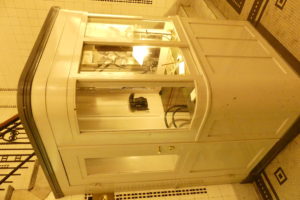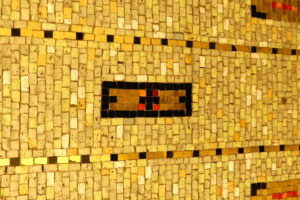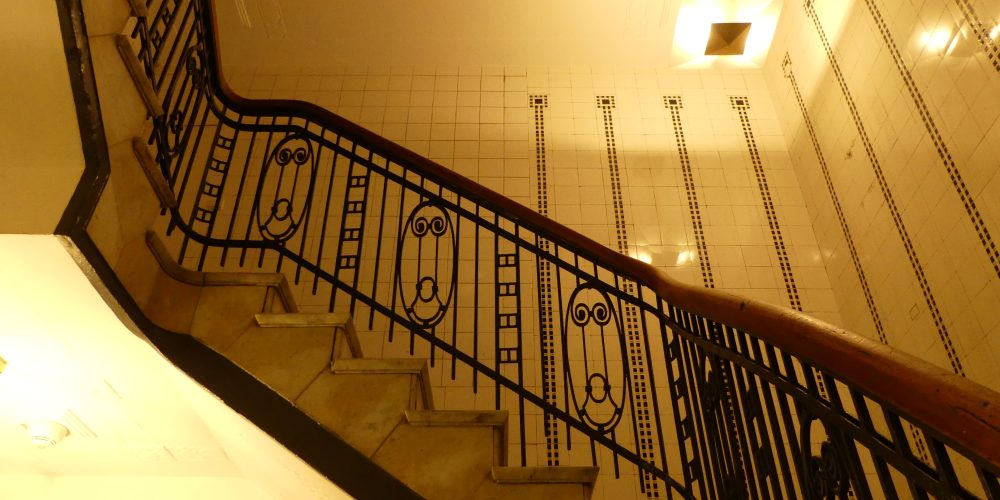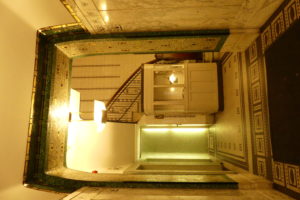Staircase up and Staircase down in the Hübner Haus
The Hübner-Haus at the corner Neuer Wall/Poststraße in Hamburg is definitely worth a detour as it accommodates at mini museum of the former Café Hübner, a café which served especially for the ladies of Hamburg’s high society between 1884 and 1961. At the beginning, this was a small revolution! The sandstone building of 1908, whose round corner fits elegantly into the city ensemble is one of the works of the autonomous architect Henry Grell, whose most popular building is probably the Hulbe-Haus Mönckebergstraße.
The tightly lined support pillars of the façade of the Hübner Haus let you sense the framing construction and integrate the pylons as a decoration. Since the copper roof is too far away from the beholder’s view and the shop windows were modernised, they have lost some of their aesthetics – as have the gently vaulted bay windows and the modest designs on the horizontal balustrades.

 Stepping into the entrance hall through the massive bronze door, one can still recognise the original elegant representation: the golden-blue mosaics and marble inlays, influenced by the Vienna Secession, sparkle, black ornamented tiles divide the white-tiled stairwell, big, decoratively framed windows let in some diffuse light, staircase pillars, designed geometrically with attention to the detail accompany the marble staircase upwards in its quadratic shape. With the reception cabin of the doorman the Hübner Haus is a piece of excellence for the hanseatic merchant.
Stepping into the entrance hall through the massive bronze door, one can still recognise the original elegant representation: the golden-blue mosaics and marble inlays, influenced by the Vienna Secession, sparkle, black ornamented tiles divide the white-tiled stairwell, big, decoratively framed windows let in some diffuse light, staircase pillars, designed geometrically with attention to the detail accompany the marble staircase upwards in its quadratic shape. With the reception cabin of the doorman the Hübner Haus is a piece of excellence for the hanseatic merchant.
TIP: Use the break during the shopping tour in the Hanseviertel for the Hübner-Haus.
Café Hübner
On July 8th, 1884, Christian Georg Adolph Hübner had his company Georg Hübner registered in the trade register and opened a small revolution in Hamburg. Together with his wife Mathilde, he created a distinguished, sophisticated café targeted especially towards the ladies of Hamburg’s high society, in the classicistic five-storey predecessor building at Poststraße/Neuer Wall, with its own confectioner’s.
In the conservative Hamburg of those days, it counted as improper for ladies to go out and enjoy themselves without the company of their male partners. Here, at Café Hübner, who made their sorbets, tarts and cakes themselves, the ladies could freely have a cup of coffee, chocolate or tea. But the good reputation of the café didn’t stay limited to Hamburg: Even the emperor’s personal chef ordered here for the “Kieler Woche”. The current building was finished in 1908, after Georg Hübner jr, the son of the founder had acquired the neighbouring plot in Poststraße. It doesn’t show many changes since then.
Revolution and inflation in the aftermath of the First World War, kept many regular clients away. The furnishing, which was put into the upper rooms in 1933, was used until the closure of the café in 1961: Made of nut and mahagoni wood, equipped with indirect lighting and a lot of fabrics, it created a cosy atmosphere. In addition to the ladies‘ saloon, it also developed a smoker’s saloon for 150 guests.
The working water pump of the café as well as the hot meals, Hanna Kirch, the café’s boss, distributed among the citizens of Hamburg assured that also during World War II people visited the Hübner.
On the day after the currency reform in 1948, miraculously everything was possible again: The Café Hübner offered again the sweetest temptations in the form of cakes, tarts and other titbits and the scent of mocha attracted guests. Many Hamburgers were very happy to be able to sit down again at Hübner and temporarily forget the sorrows of everyday life.
After the closure of the café in 1961, parts of the inventory stayed in the possession of the family and Jörg Hübner, a great-grandson of the founder, came up with the idea of using them in order to remind of the eventful history of Café Hübner. Due to his tragic death in an accident, he couldn’t fulfil his plans. The show case, which was put into the Hübner Haus in 2005 by friends and relatives, recalls the good old times of the classic café.
Architect Henry Grell
George Henry Paul Grell was born in Hamburg in 1870 and worked here as an architect since 1898. In addition to the aforementioned buildings Hübner Haus and Hulbe Haus, he designed – among others – villas in Harvestehude, mansions in Eppendorf and apartment blocks in Winterhude. He was member of the „Fassadenkommission Mönckebergstraße“ (commission for the facades of the Mönckebergstraße), member of the board of the Patriotic Society (Patriotischen Gesellschaft) and of the association of arts as well as co-founder of the regional chapter of the association of German architects. Hamburg’s newspaper wrote in 1930 that Henry Grell was standing in the first row of Hamburg’s architects thanks to the amount and especially the architectural value of his buildings so far.
Stairwells and their function(s)
Stairwells are and were not only purpose-build edifices to climb up or go down but are and were places of communication and representation. Searching for impressive and beautiful staircases today, you can find a lot of obstacles, like advertising signs, crowded shopping windows and store doors. Nevertheless, it really is worth the try!
Many of the staircases in Hamburg, especially in the accounting houses, do not let you miss any of their former splendour and decoration. Although the construction of a staircase always means a compromise between the aesthetics and economy as well as between the desires of the investor and the requirements of the architects, we can find many staircases in Hamburg comparable to reception halls – possibly thanks to the eagerness to represent their wealth of the merchants in Hamburg. At the same time, their impressive and power-radiating outsides serve to hide all of the functional parts. Decorations like carved, chiselled or cast plants, flowers and masks made of wood, stone or bronze, arcs, filigree grids, marble or granite distract from the functions of the building.
„Entrees, Foyers and stairwells are representative rooms. They establish the connection between the public street and the semi-public building, they are not outside anymore but not yet inside. Therefore, stairwells do not only fulfil the function task of linking the different floors within the edifice, the mediate, they have a communicative task as places of encounter, as a symbol of movement.”
„Hamburger Treppenhäuser“ by Allenstein and Pasdzior
TIP: Borrow that book from the public libraries of Hamburg Hamburger Bücherhallen, read and admire the pictures! There is a lot to discover! Or simply go on a guided (online) tour with me!



